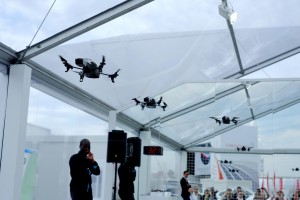2013-06-19 By Brett Davis
Although they are far from being the focus, unmanned aircraft continue to be a running feature of the Paris Air Show, ranging in size from the AR.Drone Parrot to the General Atomics Aeronautical Systems Predator.
France’s AR.Drone has upgraded its “dancing drones” exhibit to an outdoor display where the tiny aircraft twirl and dance to a musical beat.
Michael Pastor, the company’s product manager, says the company has also introduced a series of upgrades to the 2.0 model that have drawn interest from professional users, although he cautions that the Parrot is still “a toy.” They include a higher-density battery, which doubles flight time to 18 minutes and a GPS that can chart the operation of the aircraft.
Another new upgrade is Director Mode, a software system that allows users to take control of the Parrot’s high-definition camera, controlling all exposure information as well as moving the aircraft like a crane or moving it sideways to create a panorama.

The company conducted a demonstration in Africa, using the Parrot to capture images of wildlife. Although Pastor cautioned that the aircraft is a toy, he says the new software is attracting professional use of the system.
“It will help the users to make better videos,” he says. “What we have created are more standard automatic movements.”
Another French company exhibiting at the show is taking small aircraft use firmly into the professional realm. France-based Delair-Tech received type certification eight months ago for its DT-18 small UAS, as well as operator certification for its operators.
That means that purchasers of the system can fly it at altitudes of up to 150 meters (492 feet) and distances of up to 100 kilometers (62 miles), or beyond line of sight. This sort of range is useful for monitoring oil and gas pipelines, studying railways and highways — any need that can take advantage of the system’s 100-kilometer range, says Benjamin Benharrosh, the company’s business development manager.
He said the commercial interest in using unmanned aircraft for such operations is growing inside France, although the overall market remains small at the moment.
“The demand is growing now, but it’s kind of small,” he says. France has a network of gas lines and 1 million kilometers of power lines, so “the market is potentially huge, but we don’t think we will do everything by UAV,” Benharrosh says.
Other countries, such as ones in Africa and Asia, that have long pipelines, could prove to be larger markets, he says.
On the larger UAS front, the systems are becoming such valued members of the military arsenal that companies are now offering various means to protect them from enemy forces.
Israel’s Elbit Systems and sister company Elisra plan to introduce the UAS Self Protection System, based on SPS-65V5, a self-protection electronic warfare kit for manned fighter and utility aircraft.
“The increased global use of UAS is accompanied by a growing demand for survivability capabilities for these platforms, enabling protection of both the mission and the platform itself, as well as the unique and valuable sensors carried onboard,” says Edgar Maimon, general manager of Elisra.
The system is intended for mid-sized to large vehicle platforms, the companies said.
Meanwhile, Raytheon is touting its new jamming capability developed for the U.S. Army’s Gray Eagle, a member of the General Atomics Predator line. The work was done as part of the Army’s Networked Electronic Warfare, Remotely Operated system, or NERO. Two jamming payloads were delivered to the Army in 2012 as part of a $2.3 million contract.
“NERO provides critical jamming capabilities to warfighters in counter insurgency environments,” says Glen Bassett, director of Advanced Communications and Countermeasures for Raytheon’s Space and Airborne Systems business. “We leveraged our combat-proven success from the manned CEASAR program to deliver this key tactical electronic attack capability onto an unmanned application.”
Airships
Two unmanned airships are being discussed at the show, although only one actually exists at the moment. The French company Aero-Nautic Services and Equipment, or A-NSE, displayed a full-sized version of its T-C350 aerostat reconnaissance platform, which the company says will begin deployment in the Middle East in June.
Another type of airship, this one aimed at the commercial sector, is being analyzed by Altran, which wants to develop a solar-powered airship that can carry large amounts of cargo, particularly aircraft supplies for the aerospace industry.
Ali Jafaar, the company’s research and development program manager, says that current solar electric technology isn’t yet good enough, but it could improve enough in the next few years to allow such a heavy-duty airship to be built. The internal project is named Suncloud.
“We focus on future technology, because current technologies are still limited, especially solar cells,” Jafaar says.
The system so far proposed has a modular skeleton to allow it to carry payloads in a modular way and has an automatic flight control system to allow it to be unmanned. The solar cells would allow it to power itself.
“We’re still studying the technical feasibility. … We’re combining all of this in simulation,” he says. “We would like to, of course, build a small-scale model to validate our results.”
http://www.auvsi.org/1762013/1762013ParisAirShow

